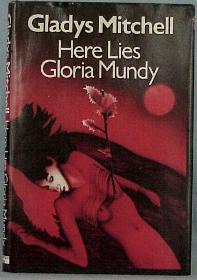Here Lies Gloria
Mundy (1982)
1982 Michael Joseph blurb:
 At
a weekend gathering of relatives and friends, Gloria Mundy, a
woman from the host’s pre-marital past, turns up unheralded
and uninvited, and her visit is followed by a series of
disturbances, domestic disagreements and two unrelated accidents.
These culminate in the discovery of a charred corpse in the
burnt-out dower house in the grounds of the mansion.
At
a weekend gathering of relatives and friends, Gloria Mundy, a
woman from the host’s pre-marital past, turns up unheralded
and uninvited, and her visit is followed by a series of
disturbances, domestic disagreements and two unrelated accidents.
These culminate in the discovery of a charred corpse in the
burnt-out dower house in the grounds of the mansion.
Dame Beatrice
Lestrange Bradley has been one of the guests, but only so that
she can cast a professional eye over the eccentric, elderly aunt
of the hostess, and she is called away before anything untoward
or dreadful comes about.
Was Gloria Mundy
a witch? What else could explain the mysterious events which
follow her unexpected arrival? What else could account for her
being seen alive in a London dress shop several weeks after she
has been found dead—apparently the victim of murder? With
the help of Corin, a young journalist who narrates the story,
Dame Beatrice painstakingly pieces together the complicated
jigsaw and leaves no stone unturned until she has unearthed the
truth.
The setting is the Cotswolds, and the place names, including
Uley, with Hetty Pegler’s Tump, and Cleeve Cloud, topped by
Belas Knap, are recalled by the author with nostalgic affection.
My review:
A return to the old Mitchell. A good book,
with strong surrealistic elements, especially in the powerful
final chapter, indicating that in the 1980s, Mitchell was
attempting a return to her style of the 1930s and 1940s.
The criminal is announced three-quarters
through, but there is no sense of anti-climax, and the attempts
to discover how the murderer committed the crime are interesting.
The mystery is solved equally by Dame Beatrice, and by the
peculiar Mme. Eglantine, the host's aunt with a bee in her
Chaucerian bonnet about witchcraft—one of the themes of the
book.
As well as Mrs. Bradley, the book abounds
with references to the Malleus Maleficorum, quoted extensively by
Mme. Eg. Gloria Mundy herself is a descendant of a witch who had
been burnt at the stake, creating her distinctive red and black
hair. Dame Beatrice herself is descended from a witch, her
ancestress Mary Toadflax having narrowly "died within
the odour of sanctity". Great-Aunt Eglantine herself
commits witchcraft at the end, believing that witchcraft must be
fought with witchcraft.
Note that Corin Stratford visited the Callanish stone circle
at midnight on Midsummer's Eve (c.f. The Whispering Knights).
To
the Bibliography
To
the Mitchell Page
To the
Grandest Game in the World
E-mail
 At
a weekend gathering of relatives and friends, Gloria Mundy, a
woman from the host’s pre-marital past, turns up unheralded
and uninvited, and her visit is followed by a series of
disturbances, domestic disagreements and two unrelated accidents.
These culminate in the discovery of a charred corpse in the
burnt-out dower house in the grounds of the mansion.
At
a weekend gathering of relatives and friends, Gloria Mundy, a
woman from the host’s pre-marital past, turns up unheralded
and uninvited, and her visit is followed by a series of
disturbances, domestic disagreements and two unrelated accidents.
These culminate in the discovery of a charred corpse in the
burnt-out dower house in the grounds of the mansion.